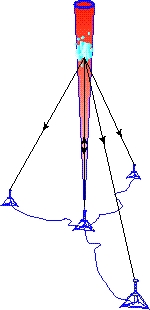Acoustical Society of America
ICA/ASA '98 Lay Language Papers
How is Acoustics Contributing to the Study of the Upper Ocean?
David M. Farmer farmerd@dfo-mpo.gc.ca
Institute of Ocean Sciences
9860 West Saanich Road
Sidney, British Columbia
V8L 4B2
Popular version of paper 1aPLb
Presented Monday morning,
June 22, 1998
ICA/ASA '98, Seattle, WA
The ocean surface is the most climatically sensitive boundary on the planet. Less than 3m of water has the same heat capacity as the entire atmosphere above it, so the transfer of heat and other properties through the air-sea interface, such as moisture, gas and momentum is of great importance.
Satellite measurements using radar and optical measurements have revolutionized our view of the oceans by providing surface observations over vast scales. But they are just surface measurements. We might infer what goes on beneath from these surface signatures, but the ocean is essentially opaque to radar and optical wavelengths. That is why acoustical measurement complements the satellite observations so well. We can use acoustical instruments to probe
the small scale processes beneath the surface to fill in the picture provided by satellites and other methods.
Acoustical views of the upper ocean
There are many examples of the ways in which acoustical methods are contributing to the solution of engineering and scientific problems in the ocean. Here are a few:
Extreme Waves: Surface waves are obviously of great importance to navigation and especially offshore engineering. For example the design of a production platform must take account of the 'largest' wave. But it is not just the size of these big waves that matter. Engineering design depends on the water speed right in the crest of big waves. Theory is not so good in these extreme situations, so we must acquire measurements. Acoustical sensors placed on the sea floor in the North Sea have recently been looking right into the crests of large waves to measure the currents. Such measurements provide an essential comparison for improved models of these hazardous phenomena.

From huge ocean waves to bubbles a hairbreadth across, acoustics is contributing to our understanding of the upper ocean. Bubbles also contribute to the exchange of gases between atmosphere and ocean. Bubbles act like tiny bells that ring with a distinct tone depending on their size. By using many acoustic frequencies researchers are able to measure the concentration of bubbles of different sizes, providing an unprecedented tool for testing concepts of turbulence, circulation and gas exchange in the upper ocean. Such measurements allow us to 'see' bubbles disperse after a wave breaks, with the larger bubbles rising to the surface while smaller ones go into solution.
Bubbles are extraordinarily effective acoustic targets, allowing sonars to detect even the smallest as they move in the turbulent upper ocean. Using a sonar like a searchlight, the organization of these bubbles can be tracked, providing ocean scientists with a remarkably clear picture of the circulation occurring beneath the surface.

Naturally occurring sound in the ocean provides additional information about wave breaking and bubble formation, rainfall and other processes. Learning how to use this signal that nature provides, tests our ability to understand the detailed physical and biological processes associated with its formation.
The age of Acoustical Oceanography is just beginning. We are learning how to make new measurements and starting to think of ways in which we can use these powerful tools. But this is a young science and exciting new advances can be expected in the next few years.